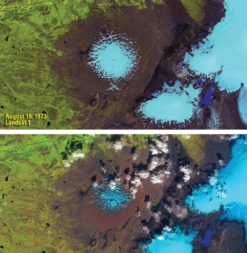NASA and the U.S. Geological Survey (USGS) plan to issue a Request for Information by the end of the year on instrumentation and platforms for Landsat Next, the Earth observation system to follow Landsat 9.
“Rather than one single large satellite bus, which is what Landsat has been historically, we’ve looked at other options,” USGS Director Jim Reilly said in an interview.
NASA and USGS recently completed an 18-month Sustainable Land Imaging Architecture Study to evaluate the capabilities of existing and planned government and commercial satellites.
“The revolution in space is underway and we’ll want to capitalize on that as much as we possibly can,” said Reilly, a former NASA astronaut. “The critical piece for NASA and USGS is looking at how we combine all that information and how we calibrate and validate it.”

Landsat, a program established in the 1970s, offers a continuous global record of land areas. Since 2008, NASA and USGS have provided Landsat data free of charge, a policy the agencies are committed to continuing, said Karen St. Germain, NASA Earth Science Division director.
NASA and USGS are preparing to launch Landsat 9 in September 2021. Landsat 9 is slightly different from its predecessor Landsat 8 in terms of the volume of data it produces but “operationally it is essentially identical to Landsat eight,” Reilly said.
Landsat Next, on the other hand, is likely to be a significant departure.
In the architecture study, “we didn’t hold anything sacred” when considering how to acquire Earth imagery “for everything from mapping to hazards to resource assessment and land use,” Reilly said. “A lot of those things now are available in a number of different platforms that can all be brought together as a system of systems.”
NASA and USGS may consider sharing Earth observation imagery obtained by other U.S. government agencies. NASA and USGS could work, for example, with the National Geospatial Intelligence Agency to obtain data that “can be used by the whole government in the future,” Reilly said.
In addition, NASA and the USGS evaluated opportunities to work with international allies conducting initiatives like the European Space Agency’s Sentinel land imaging program.
For now, that’s all NASA and USGS officials will say about Landsat Next.
“NASA and USGS anticipate being able to share information about the next Landsat mission in more detail following the planned release of the fiscal year 2022 president’s budget request in February 2021,” St. Germain said by email.
LANDSAT 9
In the meantime, NASA and USGS attention turns to Landsat 9, a satellite built by Northrop Grumman in Gilbert, Arizona, to house the Operational Land Imager 2 from Ball Aerospace in Boulder, Colorado, and the Thermal Infrared Sensor 2 from NASA’s Goddard Space Flight Center in Greenbelt, Maryland.
The price tag for Landsat 9 program, including the satellite, launch and flight operations plus imagery collection, data processing and dissemination over multiple years, is expected to be around $1 billion.
A 2019 report published by the U.S. Interior Department and USGS, “Economic Valuation of Landsat,” determined the 2017 imagery was worth more than $3.4 billion to international users and worth approximately $2.1 billion to U.S. customers alone.
“Studies have shown Landsat provides multibillion dollar annual economic benefits to the nation in support of applications including agriculture monitoring and forecasting, water resource management, wildfire mapping and remediation, forest and rangeland management, and hazards monitoring and mitigation,” Tim Newman, USGS National Land Imaging director, said by email.
This article originally appeared in the Sept. 14, 2020 issue of SpaceNews magazine.
The Link LonkSeptember 28, 2020 at 04:50PM
https://spacenews.com/landsat-next-likely-to-bear-little-resemblance-to-its-predecessors/
Landsat Next likely to bear little resemblance to its predecessors - SpaceNews
https://news.google.com/search?q=little&hl=en-US&gl=US&ceid=US:en

No comments:
Post a Comment